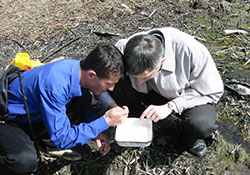WHO’s strategy for malaria elimination

WHO
In 2006, WHO/Europe adopted the new Regional Strategy: the Move from Malaria Control to Elimination in the WHO European Region 2006–2015. This followed the successful implementation of a strategy that curbed a regional epidemic of malaria and reduced incidence in affected countries to levels that made eliminating the disease feasible. WHO/Europe based the rationale for developing the new strategy on the following principles:
- the demonstrated feasibility of malaria elimination in Europe;
- the current impact of malaria control interventions;
- the strong political commitment to achieve a greater impact on malaria at the national level; and
- the efficacious technologies and tools available to control and eliminate malaria in the Region.
The inception meeting, held in Tashkent, Uzbekistan in 2005, resulted in the Tashkent Declaration: "The Move from Malaria Control to Elimination". Representatives of malaria-affected countries participating in this meeting consented to the Declaration, which was later endorsed by their health ministers.
The ultimate goal of the Regional Strategy was to interrupt the transmission of malaria by 2015 and eliminate the disease in the affected countries of the Region. The Strategy focused on maintaining malaria-free status in areas and countries where the disease has been eliminated, and emphasized tackling the growing problem of imported malaria.
The Strategy called for:
- ultimately interrupting transmission in countries where malaria is a focal problem and there is clear evidence of political support for, technical feasibility of and operational applicability of malaria elimination;
- further reducing incidence and prevalence in countries where elimination does not currently appear to be feasible;
- preventing the re-establishment of transmission in countries and territories where malaria has been eliminated; and
- reducing and preventing deaths from imported malaria.



